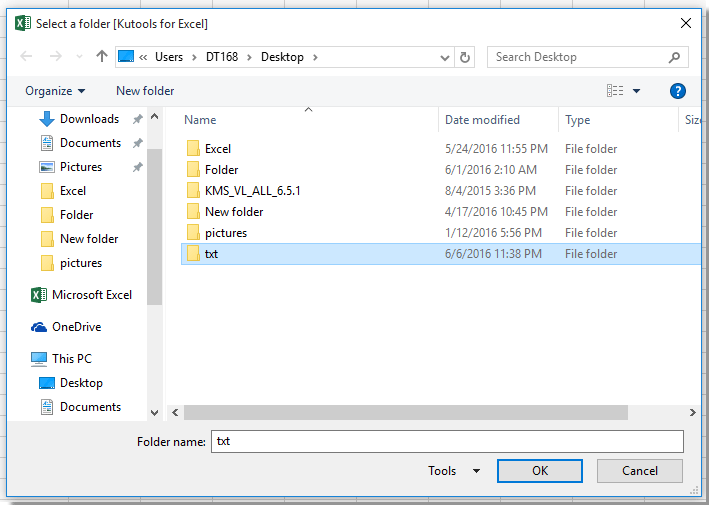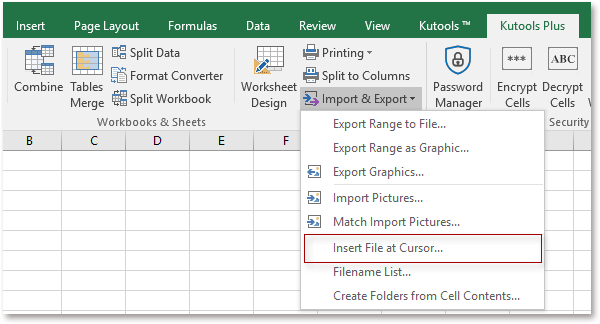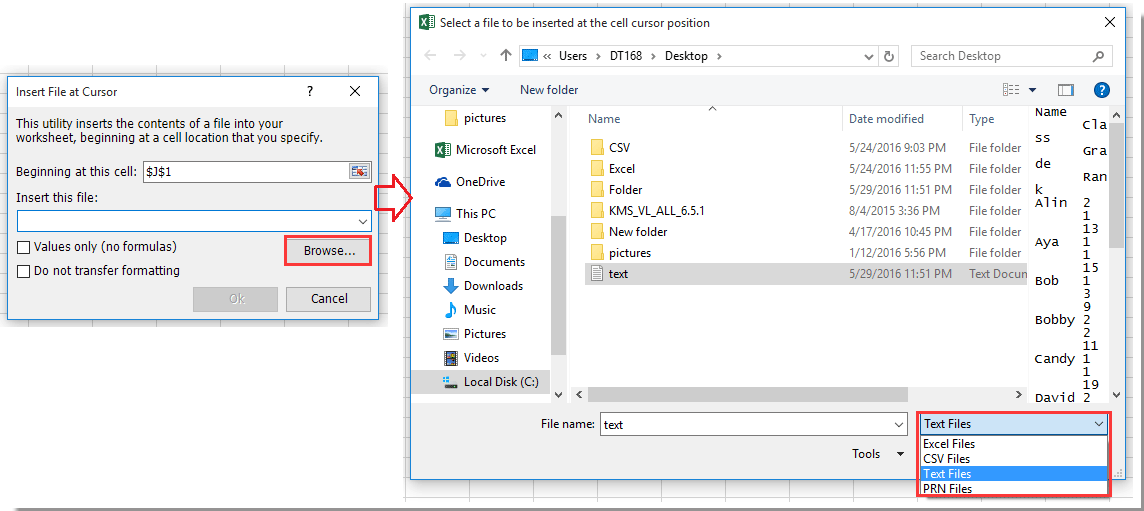Πώς να εισαγάγετε πολλά αρχεία κειμένου από ένα φάκελο σε ένα φύλλο εργασίας;
Για περιπτώσεις, εδώ έχετε έναν φάκελο με πολλά αρχεία κειμένου, αυτό που θέλετε να κάνετε είναι να εισαγάγετε αυτά τα αρχεία κειμένου σε ένα μόνο φύλλο εργασίας, όπως φαίνεται παρακάτω. Αντί να αντιγράφετε τα αρχεία κειμένου ένα προς ένα, υπάρχουν κόλπα για γρήγορη εισαγωγή των αρχείων κειμένου από έναν φάκελο σε ένα φύλλο;
Εισαγάγετε πολλά αρχεία κειμένου από έναν φάκελο σε ένα μόνο φύλλο με VBA
Εισαγωγή αρχείου κειμένου στο ενεργό κελί με το Kutools για Excel ![]()
Εισαγάγετε πολλά αρχεία κειμένου από έναν φάκελο σε ένα μόνο φύλλο με VBA
Εδώ είναι ένας κωδικός VBA που μπορεί να σας βοηθήσει να εισαγάγετε όλα τα αρχεία κειμένου από έναν συγκεκριμένο φάκελο σε ένα νέο φύλλο.
1. Ενεργοποιήστε ένα βιβλίο εργασίας που θέλετε να εισαγάγετε αρχεία κειμένου και πατήστε Alt + F11 πλήκτρα για ενεργοποίηση Microsoft Visual Basic για εφαρμογές παράθυρο.
2. κλικ Κύριο θέμα > Μονάδα μέτρησης, αντιγράψτε και επικολλήστε κάτω από τον κώδικα VBA στο Μονάδα μέτρησης παράθυρο.
VBA: Εισαγωγή πολλαπλών αρχείων κειμένου από έναν φάκελο σε ένα φύλλο
Sub Test()
'UpdatebyExtendoffice6/7/2016
Dim xWb As Workbook
Dim xToBook As Workbook
Dim xStrPath As String
Dim xFileDialog As FileDialog
Dim xFile As String
Dim xFiles As New Collection
Dim I As Long
Set xFileDialog = Application.FileDialog(msoFileDialogFolderPicker)
xFileDialog.AllowMultiSelect = False
xFileDialog.Title = "Select a folder [Kutools for Excel]"
If xFileDialog.Show = -1 Then
xStrPath = xFileDialog.SelectedItems(1)
End If
If xStrPath = "" Then Exit Sub
If Right(xStrPath, 1) <> "\" Then xStrPath = xStrPath & "\"
xFile = Dir(xStrPath & "*.txt")
If xFile = "" Then
MsgBox "No files found", vbInformation, "Kutools for Excel"
Exit Sub
End If
Do While xFile <> ""
xFiles.Add xFile, xFile
xFile = Dir()
Loop
Set xToBook = ThisWorkbook
If xFiles.Count > 0 Then
For I = 1 To xFiles.Count
Set xWb = Workbooks.Open(xStrPath & xFiles.Item(I))
xWb.Worksheets(1).Copy after:=xToBook.Sheets(xToBook.Sheets.Count)
On Error Resume Next
ActiveSheet.Name = xWb.Name
On Error GoTo 0
xWb.Close False
Next
End If
End Sub3. Τύπος F5 για να εμφανιστεί ένα παράθυρο διαλόγου και επιλέξτε ένα φάκελο που περιέχει αρχεία κειμένου που θέλετε να εισαγάγετε. Δείτε το στιγμιότυπο οθόνης:
4. κλικ OK. Στη συνέχεια, τα αρχεία κειμένου έχουν εισαχθεί στο ενεργό βιβλίο εργασίας ως νέο φύλλο ξεχωριστά.
Εισαγωγή αρχείου κειμένου στο ενεργό κελί με το Kutools για Excel
Εάν θέλετε να εισαγάγετε ένα αρχείο κειμένου σε ένα συγκεκριμένο κελί ή εύρος, μπορείτε να υποβάλετε αίτηση Kutools για Excel'S Εισαγωγή αρχείου στο δρομέα χρησιμότητα.
| Kutools για Excel, με περισσότερα από 300 εύχρηστες λειτουργίες, διευκολύνει τις εργασίες σας. | ||
Μετά το δωρεάν εγκατάσταση Kutools για Excel, κάντε τα παρακάτω:
1. Επιλέξτε ένα κελί που θέλετε να εισαγάγετε το αρχείο κειμένου και κάντε κλικ στο Kutools Plus > Εισαγωγή εξαγωγή > Εισαγωγή αρχείου στο δρομέα. Δείτε το στιγμιότυπο οθόνης:
2. Στη συνέχεια, εμφανίζεται ένας διάλογος, κάντε κλικ στο Αναζήτηση για να εμφανιστεί το Επιλέξτε ένα αρχείο για εισαγωγή στο παράθυρο διαλόγου θέσης του δρομέα κελιού, στη συνέχεια επιλέξτε Αρχεία κειμένου από την αναπτυσσόμενη λίστα και, στη συνέχεια, επιλέξτε το αρχείο κειμένου που θέλετε να εισαγάγετε. Δείτε το στιγμιότυπο οθόνης:
3. κλικ Ανοικτό > Okκαι το αρχείο καθορισμού κειμένου έχει εισαχθεί στη θέση του δρομέα, δείτε το στιγμιότυπο οθόνης:
Εισαγωγή / Εισαγωγή αρχείου κειμένου στον κέρσορα
Τα καλύτερα εργαλεία παραγωγικότητας γραφείου
Αυξήστε τις δεξιότητές σας στο Excel με τα Kutools για Excel και απολαύστε την αποτελεσματικότητα όπως ποτέ πριν. Το Kutools για Excel προσφέρει πάνω από 300 προηγμένες δυνατότητες για την ενίσχυση της παραγωγικότητας και την εξοικονόμηση χρόνου. Κάντε κλικ εδώ για να αποκτήσετε τη δυνατότητα που χρειάζεστε περισσότερο...

Το Office Tab φέρνει τη διεπαφή με καρτέλες στο Office και κάνει την εργασία σας πολύ πιο εύκολη
- Ενεργοποίηση επεξεργασίας και ανάγνωσης καρτελών σε Word, Excel, PowerPoint, Publisher, Access, Visio και Project.
- Ανοίξτε και δημιουργήστε πολλά έγγραφα σε νέες καρτέλες του ίδιου παραθύρου και όχι σε νέα παράθυρα.
- Αυξάνει την παραγωγικότητά σας κατά 50% και μειώνει εκατοντάδες κλικ του ποντικιού για εσάς κάθε μέρα!
